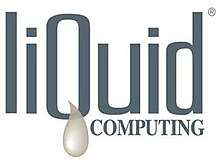Liquid Computing
| Private company | |
| Industry | Unified computing |
| Founded | Ottawa, Ontario (2003) |
| Headquarters | Ottawa, Ontario, Canada |
| Products | See |
| Website | www.liquidcomputing.com |

Liquid Computing was an information technology business that sold servers, storage, and networking systems. It was founded in 2003 and ceased operations in 2010.
The company had customers in North America and established partnerships with companies such as Intel, Microsoft, VMWare, Oracle, Red Hat, NetApp and AMD.
Corporate Information
Office Locations
The Liquid Computing Corporation was headquartered in Ottawa, Ontario, Canada with U.S. offices.
Investors
The following Investors have funded Liquid Computing:
- VenGrowth
- ATA Ventures
- BDC (Business Development Bank of Canada)
- EDC (Export Development Canada)
- Axis Capital
- Newbury Ventures
History
- 2003 – Liquid Computing is founded by Brian Hurley (who later went on to found Purple Forge)and Mike Kemp, two Canadian engineers from telecom equipment maker Nortel with experience building supercomputers for the U.S. government's Defense Advance Research Project Agency (DARPA).
- 2006 – LiquidIQ 1.0 is introduced for High-Performance Computing using its own interconnect scheme coupled with AMD's HyperTransport architecture and running a modified version of Red Hat Linux.
- 2008 – LiquidIQ 2.0 is released; a unified computing system that combines standard physical data center resources, such as servers, switching, operating systems, network interfaces and storage, with management and control software.
- 2009 – The company announces LiquidIQ 3.0 unified computing system powered by Intel Xeon 5500 (Nehalem) Series Processors.
- Q4 2009 – The company introduces Liquid Elements, a unified computing solution that extends the power of unified computing across datacenter hardware from leading vendors. Current solution configuration combines with Intel Server System SR1680MV and NetApp storage.
- February 2010 – The company shuts down.
References
- If the Data Center Is the Computer the Fight Is on to Control the Ecosystem – GigaOM
- A True Datacenter In A Box – Network Computing
- Liquid to float slushy Intel servers – The Register
- Fast-growing Liquid Computing at a 'watershed moment' – Ottawa Citizen
- Can Liquid Computing ride Cisco's California coattails? – The Register
- The Liquid Approach To Unified Computing – ITBusinessEdge
- Liquid Computing – fast out of the starting gate – Network World
- 451 Group Impact Report
External links
This article is issued from
Wikipedia.
The text is licensed under Creative Commons - Attribution - Sharealike.
Additional terms may apply for the media files.